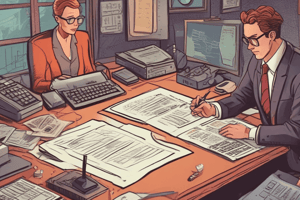Podcast
Questions and Answers
What does the 'C' in COPE stand for in the context of property underwriting?
What does the 'C' in COPE stand for in the context of property underwriting?
- Construction (correct)
- Cost
- Compliance
- Condition
Which hazard is characterized by carelessness or indifference leading to potential losses?
Which hazard is characterized by carelessness or indifference leading to potential losses?
- Environmental hazard
- Moral hazard
- Market hazard
- Morale hazard (correct)
What does a combined ratio greater than 100 indicate for an insurance company?
What does a combined ratio greater than 100 indicate for an insurance company?
- Sustained growth
- Break-even performance
- Profit from underwriting
- Loss from underwriting (correct)
How is public fire protection defined?
How is public fire protection defined?
Which of the following is NOT a component evaluated in nonfinancial measures for monitoring underwriting results?
Which of the following is NOT a component evaluated in nonfinancial measures for monitoring underwriting results?
What is the purpose of a loss run report in underwriting?
What is the purpose of a loss run report in underwriting?
What does the retention ratio represent in insurance?
What does the retention ratio represent in insurance?
Which aspect is evaluated by underwriters to analyze loss exposures from surrounding properties?
Which aspect is evaluated by underwriters to analyze loss exposures from surrounding properties?
What does residual risk include?
What does residual risk include?
Which analysis technique is used to evaluate a product's safety?
Which analysis technique is used to evaluate a product's safety?
What characterizes tangible costs?
What characterizes tangible costs?
What does deductive analysis involve?
What does deductive analysis involve?
Which type of workers most commonly use dynamic risk assessments?
Which type of workers most commonly use dynamic risk assessments?
What is the primary goal of risk management?
What is the primary goal of risk management?
Which statement accurately describes risk homeostasis?
Which statement accurately describes risk homeostasis?
Which analysis leads with a bottom-up approach?
Which analysis leads with a bottom-up approach?
What does risk financing primarily rely on for its management?
What does risk financing primarily rely on for its management?
What is meant by 'frequency' in the context of analyzing losses?
What is meant by 'frequency' in the context of analyzing losses?
Which control type actively discourages individuals from violating security policies?
Which control type actively discourages individuals from violating security policies?
What role does an underwriter play in personal umbrella policies?
What role does an underwriter play in personal umbrella policies?
Which of the following is an example of a recovery control?
Which of the following is an example of a recovery control?
What is a key characteristic of an umbrella policy?
What is a key characteristic of an umbrella policy?
What does societal risk estimate?
What does societal risk estimate?
What is the primary purpose of physical controls in risk management?
What is the primary purpose of physical controls in risk management?
What distinguishes pure risk from speculative risk?
What distinguishes pure risk from speculative risk?
Which of the following describes a corrective control?
Which of the following describes a corrective control?
What is the primary goal of safety and health programs?
What is the primary goal of safety and health programs?
What is the purpose of Fault Tree Analysis (FTA)?
What is the purpose of Fault Tree Analysis (FTA)?
In failure analysis, what does common cause failure analysis identify?
In failure analysis, what does common cause failure analysis identify?
What technique refers to the formal analysis of a system to determine hazards?
What technique refers to the formal analysis of a system to determine hazards?
What differentiates inductive analysis from deductive analysis?
What differentiates inductive analysis from deductive analysis?
What ratio defines the failure rate?
What ratio defines the failure rate?
What is the primary concern for underwriters in umbrella and excess liability underwriting?
What is the primary concern for underwriters in umbrella and excess liability underwriting?
What does facultative reinsurance allow a primary insurer to do?
What does facultative reinsurance allow a primary insurer to do?
How do underwriting guidelines benefit insurers?
How do underwriting guidelines benefit insurers?
What is the purpose of telematics in insurance?
What is the purpose of telematics in insurance?
Catastrophe insurance primarily covers which type of events?
Catastrophe insurance primarily covers which type of events?
What does the term 'retrocession' refer to in the context of reinsurance?
What does the term 'retrocession' refer to in the context of reinsurance?
Which of the following is NOT one of the categories identified by the Human Factors Theory?
Which of the following is NOT one of the categories identified by the Human Factors Theory?
Why are premium audits conducted by insurers?
Why are premium audits conducted by insurers?
What does the term retrocession refer to in risk management?
What does the term retrocession refer to in risk management?
Which one of the following is a characteristic of the Fail Safe Passive system?
Which one of the following is a characteristic of the Fail Safe Passive system?
What is the primary focus of safety and health programs in the workplace?
What is the primary focus of safety and health programs in the workplace?
Which principle states that work expands to fill the time available for its completion?
Which principle states that work expands to fill the time available for its completion?
In risk management, what does the probability measure?
In risk management, what does the probability measure?
What does vicarious liability mean in a legal context?
What does vicarious liability mean in a legal context?
Which risk analysis technique evaluates the impact of control measures added to a simple system?
Which risk analysis technique evaluates the impact of control measures added to a simple system?
Which statement best describes 'standard deviation' in statistics?
Which statement best describes 'standard deviation' in statistics?
What does the Pareto Principle, sometimes referred to as the 80/20 Rule, imply?
What does the Pareto Principle, sometimes referred to as the 80/20 Rule, imply?
What is a hazard in the context of workplace safety?
What is a hazard in the context of workplace safety?
Which of the following is NOT a control measure for risk management?
Which of the following is NOT a control measure for risk management?
Which of the following is a recommended practice for risk communication?
Which of the following is a recommended practice for risk communication?
What does a T-test compare in statistics?
What does a T-test compare in statistics?
Flashcards
Underlying Insurer
Underlying Insurer
The insurer that provides coverage on top of the primary insurance policy, often used for high-value risks.
Loss Analysis
Loss Analysis
Analyzing the insured's business to identify potential risks and evaluate their past losses.
Loss Severity
Loss Severity
The primary concern in umbrella and excess liability underwriting, focusing on the potential magnitude of a loss rather than its likelihood.
Reinsurance
Reinsurance
Signup and view all the flashcards
Facultative Reinsurance
Facultative Reinsurance
Signup and view all the flashcards
Underwriting Guidelines
Underwriting Guidelines
Signup and view all the flashcards
Hazard
Hazard
Signup and view all the flashcards
Premium Audit
Premium Audit
Signup and view all the flashcards
What is a loss run?
What is a loss run?
Signup and view all the flashcards
What is a morale hazard?
What is a morale hazard?
Signup and view all the flashcards
What is private fire protection?
What is private fire protection?
Signup and view all the flashcards
What is a fire division?
What is a fire division?
Signup and view all the flashcards
What is public fire protection?
What is public fire protection?
Signup and view all the flashcards
What is a rating plan?
What is a rating plan?
Signup and view all the flashcards
What is a combined ratio?
What is a combined ratio?
Signup and view all the flashcards
What are non-financial measures used for underwriting?
What are non-financial measures used for underwriting?
Signup and view all the flashcards
Transfer of Risk
Transfer of Risk
Signup and view all the flashcards
Personal Umbrella Policy
Personal Umbrella Policy
Signup and view all the flashcards
Underwriting
Underwriting
Signup and view all the flashcards
Physical Controls
Physical Controls
Signup and view all the flashcards
Technical Controls
Technical Controls
Signup and view all the flashcards
Directive Control
Directive Control
Signup and view all the flashcards
Deterrent Control
Deterrent Control
Signup and view all the flashcards
Preventative Control
Preventative Control
Signup and view all the flashcards
Societal risk
Societal risk
Signup and view all the flashcards
Individual risk
Individual risk
Signup and view all the flashcards
MORT (Management Oversight and Risk Tree)
MORT (Management Oversight and Risk Tree)
Signup and view all the flashcards
Fault Tree Analysis (FTA)
Fault Tree Analysis (FTA)
Signup and view all the flashcards
Cost-Benefit Analysis (CBA)
Cost-Benefit Analysis (CBA)
Signup and view all the flashcards
Pure risk
Pure risk
Signup and view all the flashcards
Speculative risk
Speculative risk
Signup and view all the flashcards
System hazard analysis
System hazard analysis
Signup and view all the flashcards
What is risk?
What is risk?
Signup and view all the flashcards
What is residual risk?
What is residual risk?
Signup and view all the flashcards
What is Pareto analysis?
What is Pareto analysis?
Signup and view all the flashcards
What is FMEA?
What is FMEA?
Signup and view all the flashcards
What is Fault Tree Analysis?
What is Fault Tree Analysis?
Signup and view all the flashcards
What are dynamic risk assessments?
What are dynamic risk assessments?
Signup and view all the flashcards
What is formal hazard analysis?
What is formal hazard analysis?
Signup and view all the flashcards
What are the different types of costs?
What are the different types of costs?
Signup and view all the flashcards
Retrocession
Retrocession
Signup and view all the flashcards
Indemnification Agreement
Indemnification Agreement
Signup and view all the flashcards
Yates' Human Factors Theory
Yates' Human Factors Theory
Signup and view all the flashcards
Petersen's Accident/Incident Theory
Petersen's Accident/Incident Theory
Signup and view all the flashcards
Vicarious Liability
Vicarious Liability
Signup and view all the flashcards
Peter Principle
Peter Principle
Signup and view all the flashcards
Parkinson’s Principle
Parkinson’s Principle
Signup and view all the flashcards
Pareto Principle (80/20 Rule)
Pareto Principle (80/20 Rule)
Signup and view all the flashcards
Fail Safe Passive
Fail Safe Passive
Signup and view all the flashcards
Fail Safe Active
Fail Safe Active
Signup and view all the flashcards
Fail Safe Operational
Fail Safe Operational
Signup and view all the flashcards
Z score
Z score
Signup and view all the flashcards
T-test
T-test
Signup and view all the flashcards
Study Notes
Risk-Based Auditing
- Prioritizes use of limited internal audit resources in areas posing greatest risk to the organization
- Emphasizes auditing to business objectives, focusing on materiality of risk, and identifying threats to business goals.
Risk Management and Organizational Alignment
- Provides insurance and risk management solutions to control or contain losses and satisfy customers.
- Common objectives include balancing risk and reward, supporting decision-making, achieving goals such as tolerable uncertainty, legal and regulatory compliance, survival, business continuity, earnings stability, profitability, growth, and social responsibility
Underwriting
- Helps insurers develop and maintain a profitable book of business by minimizing adverse selection, ensuring adequate policyholder's surplus, and enforcing underwriting guidelines
- Underwriters select insureds, classify accounts, price accounts, recommend coverage, manage a book of business, support producers, insureds and support marketing objectives
Staff Underwriters
- Research the market, formulate underwriting policies, revise underwriting guidelines, evaluate loss experience, develop coverage forms, review rates, arrange reinsurance, assist with complex accounts, and conduct underwriting audits.
Underwriting Policy
- Provides a guide to individual and aggregate policy selection that supports an insurer's mission statement
Essential Knowledge for Underwriters
- Successful underwriters possess knowledge of insurance principles, practices, loss exposures and pricing, insurance rates, loss analysis and internal/external information sources
Rating
- (Information omitted, page contains only rating header)
Rating (Page 2)
- Involves applying an applicable rate and rating plan to an exposure, and performing necessary calculations to determine the policy premium.
Moral Hazard (Page 2)
- A condition increasing the likelihood of intentional loss or exaggeration
Property Application (Page 2)
- Underwriters examine crucial information, including loss history, COPE elements and property values.
Supplemental Information (Page 2)
- Information like risk management programs, financial statements, risk control reports, and property valuation guides further assesses a property account's quality.
COPE and Loss Run (Page 2)
- COPE elements include construction, occupancy, protection, and external exposures, analyzed by commercial property underwriters
- Loss run: a report detailing an insured's claims history over a specific period
Morale Hazard (Page 2)
- A condition of carelessness or indifference increasing the frequency or severity of loss
Fire Protection and Division (Page 2)
- Underwriters analyze loss exposures posed by immediate neighboring properties or the surrounding area.
- A fire division is a section of a structure protected to prevent fire spread to another section.
Public and Private Fire Protection (Page 2)
- Public fire protection: equipment and services available from the government.
- Private fire protection: measures taken by property owners to protect their assets.
Residential and Occupational Loss Exposures (Page 3)
- Underwriters evaluate residential losses considering guest hazards.
- Personal insurance applications contain questions about occupation or employment to determine potential loss frequency and severity.
Rating Plan (Page 3)
- A set of directions specifying criteria for determining premiums for a particular line of insurance, based on exposure base, exposure unit, and rate per exposure unit.
Combined Ratio (Page 3)
- A ratio of less than 100 indicates underwriting profit.
- A ratio of more than 100 indicates underwriting loss.
Nonfinancial Measures (Page 3)
- Used to monitor underwriting results including selection, pricing, product /line of business mix, retention ratio, hit ratio, and customer service.
Retention Ratio (Page 3)
- The percentage of expiring policies an insurer renews.
- Higher retention rates indicate profitability due to existing relationships.
Hit Ratio (Page 3)
- Compares policies written with applications quoted to evaluate underwriter performance in meeting sales goals.
Physical Controls (Page 3)
(Information omitted, page contains only physical controls header)
Technical Controls (Page 4)
- Logical controls in the computing environment, e.g. operating systems, application programs, database frameworks, and firewalls
Directive Control (Page 4)
- Specifies expected employee behavior, often in the form of policies and guidelines, e.g., acceptable use policy.
Deterrent Control (Page 4)
- Discourages individuals from violating policies due to the effort to circumvent them and the associated consequences, e.g., CCTV monitoring
Preventative Control (Page 4)
- Stops a security incident, e.g., background screenings
Compensating Control (Page 4)
- Implemented when the system can't provide all required policy protection; to reduce risk down to an acceptable level, e.g., an agreed exceptional process.
Detective Control (Page 4)
- Alerts security professionals to attempted security violations
Corrective Control (Page 4)
- Responds to security violations to reduce or eliminate impact, e.g., escorting unauthorized persons offsite
Hazard (Page 4)
- A condition or activity with potential harm
Risk (Page 4)
- Probability of injury, loss, or hazard
Incident (Page 4)
(Information omitted, Page contains only incident header)
Risk Response Strategies (Page 5)
- Avoidance, Transfer, Retention, and Reduction
ALARA and ALARP (Page 5)
- As Low As Reasonably Achievable
- As Low As Reasonably Practical
Loss Control Measures (Page 5)
- Examples include Hazcom training, machine guards, and confined space programs
Domino Theory (Page 5)
- All accidents caused by a chain of events, removing any chain prevents accident.
Petersen's Accident/Incident Theory (Page 5)
- Accident/incident causes due to human error and/or system failure.
Risk Analysis vs. Risk Management (Page 5)
- Risk Analysis: estimates risk scientifically
- Risk Management: determines whether risk is acceptable and establishes strategies for reduction.
Hazard Analysis Categories (Page 5)
- Three categories (omitted, page contains header only)
Environmental Issues (Page 6)
- Issues causing stress, hazards and failures.
Primary Methods for Reducing Accidents (Page 6)
- Prevention (loss control)
- Financial (cost reduction)
Objectives of Risk Management (Page 6)
- Reducing anxiety before a loss.
- Meeting corporate responsibility.
- Continued growth after loss.
Poka-Yoke (Page 6)
- Lean manufacturing technique preventing or detecting errors.
- Mistake-proofing methods to ensure fail-safe systems minimizing human error.
Kaizen (Page 6)
- Japanese term for continuous improvement.
- 5-S an effective housekeeping technique: Sort, Straighten, Scrub, Standardize.
Risk Management Techniques (Page 6)
- Risk control: measures preventing or reducing losses
- Risk financing: insurance to help pay for losses.
Risk Management (Page 6)
- Feasibility assessment (omitted, page contains only risk management header)
Financial Considerations (Page 7)
- Forecasted losses, insurance types, deductibles
Non-Financial Considerations (Page 7)
- Business operations, customer and employee safety, and reputation
Risk Management Techniques Techniques (Page 7)
- Risk financing methods implemented by risk management professionals
- Risk control methods implemented by operations managers, requiring communication and training
Insurance (Page 7)
- Rating plan: criteria for exposure base, exposure unit, and rate per exposure unit to determine premiums
- Combined ratio: ratio of less than 100 indicates underwriting profit; ratio more than 100 indicates no underwriting profit
- Non-financial measures to monitor underwriting results: selection, product/line of business mix, pricing, retention ratio, hit ratio, and customer service
Retention Ratio (Page 7)
- Percentage of expiring policies an insurer renews
Underwriting (Page 7)
- Details percentage of renewal policies compared to new business
- Underwriting elements: limits of liability, deductibles, underlying insurance, loss severity
Reinsurance (Page 7)
- Transferring risk to another insurer through contract
- Facultative reinsurance: primary insurer submits loss exposures for individual review and acceptance by reinsurer.
Underwriting Guidelines (Page 7)
- Written manual guiding policy decisions, specifying attributes of insurable accounts.
Qualitative and Quantitative Risk Assessment (Page 7)
- Qualitative uses non-numeric values to estimate risk
- Quantitative uses numerical data from historical events or instances of risk.
- Including methods like Delphi Methods, Facilitated Risk Analysis Process (FRAP), and Operationally Critical Threat, Asset and Vulnerability Evaluation (OCTAVE)
(Remaining notes are too long to extract as bullet points and are best read as a whole, as many depend on preceding ones)
Studying That Suits You
Use AI to generate personalized quizzes and flashcards to suit your learning preferences.




